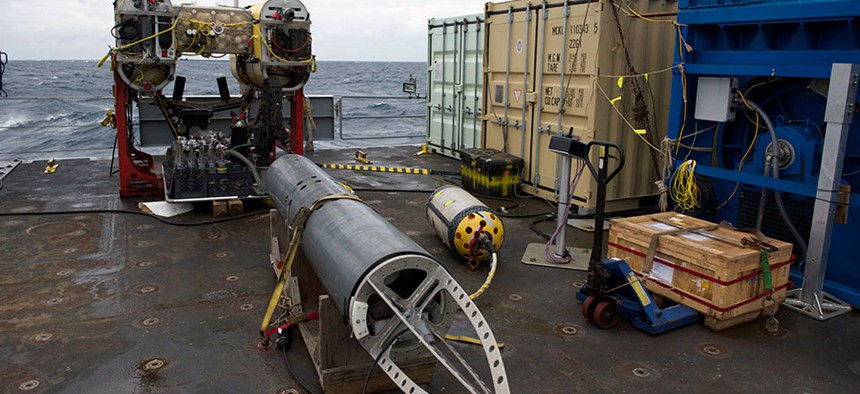Goodbye Forever, Beloved Robot

Nereus was a deep-diving oceanic robot. Ken Kostel, Woods Hole Oceanographic Institution
Grieving a machine that helped us ask deep questions
Scientists broke the news in the style of French existentialist Albert Camus: "We lost Nereus today," Ken Kostel wrote of the deep-ocean robot, which imploded six miles beneath the surface of the Pacific last weekend.
Kostel is a writer at the Woods Hole Oceanographic Institution. Nereus was one of the institution's prized robots. It died while on a mission in the Kermadec Trench, one of the world's deepest undersea grooves, just 10 days away from completing a 40-day expedition.
Nereus was about to complete the deepest dive of its mission when its video feed "abruptly went dark." This had happened before, and scientists weren't concerned. Nereus could still reach the surface with its lines of communication down; it would just take longer than usual. But Nereus didn't surface in one piece. Fragments appeared as white dots in the water. "By then we knew," Kostel said. "Nereus was gone."
His tribute is, simply put, heartbreaking. Technological loss often is. A stolen laptop begins as a pit in one's stomach. An iPhone left in the backseat of a taxi is a rush of panic. Devices can be replaced, but not always without anguish. Losing a machine means forgetting a part of ourselves. And Nereus was a big one.
Nereus wasn't just an ultra-expensive machine. It—and calling Nereus "it" feels too cold, even—was also the physical manifestation of the sense of wonder that makes us human. Nereus was a vehicle for human curiosity that is as absurd as it is familiar. We want to know. We can't stand not knowing. "This hurts," Kostel wrote. "But we’ll continue to do what we came here to do because in the end this is about learning something about a place that does not give up its secrets easily."
The Ancient Greeks knew Nereus as a Titan god, and the shape-shifting prophet son of sea and Earth. In mythology, he was the link between the deep-ocean world and the land of men, and considered a truthful guide to humans traveling the seas. Robot Nereus was one of the most important machines in the Hadal Ecosystem Studies Project—a reference to the deep-sea hadal zone .

Scientists long believed life in the hadal zone was scarce, but Nereus and other robots have proved otherwise. We know that these trenches are home to giant shrimp, cusk eels, and sea cucumbers, but scientists are only just beginning to understand how they thrive in a world of darkness.
Grabbing a Quick Bite from Woods Hole Oceanographic Inst. on Vimeo .
Four days after Nereus' last mission, the sense of loss is still acute among scientists finishing the expedition without their robot. "This is new territory," Kostel wrote on Monday . "And that is why we’re out here—to identify new questions to ask and to push against that flimsy yet frustrating boundary between what we know and what we don’t know."
All this is a fresh reminder that scientific discovery is a painful pursuit. The opportunities for breakthroughs are rare, and the disappointments can be grave. And so the asking is what propels us. The wanting to know is what sends us back to the sea, to the stars, and beyond.





